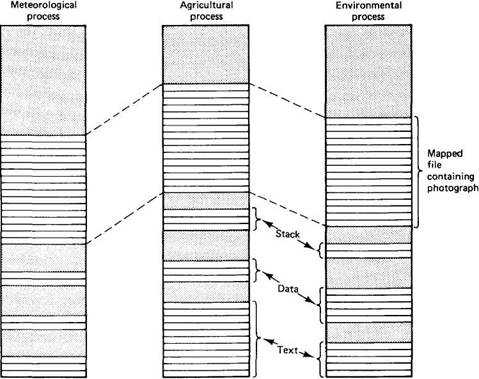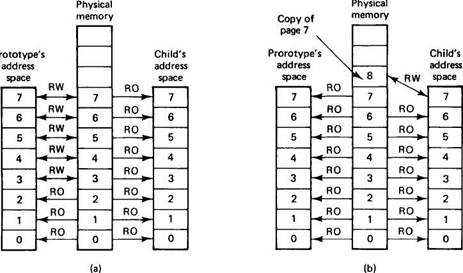Книга: Distributed operating systems
8.3.2. Memory Sharing
8.3.2. Memory Sharing
Sharing plays an important role in Mach. No special mechanism is needed for the threads in a process to share objects: they all see the same address space automatically. If one of them has access to a piece of data, they all do. More interesting is the possibility of two or more processes sharing the same memory objects, or just sharing data pages, for that matter. Sometimes sharing is important on single CPU systems. For example, in the classical producer-consumer problem, it may be desirable to have the producer and consumer be different processes, yet share a common buffer so that the producer can put data into the buffer and the consumer can take data out of it.
On multiprocessor systems, sharing of objects between two or more processes is frequently even more important. In many cases, a single problem is being solved by a collection of cooperating processes running in parallel on different CPUs (as opposed to being timeshared on a single CPU). These processes may need access to buffers, tables, or other data structures continuously, in order to do their work. It is essential that the operating system allow this sharing to take place. Early versions of UNIX did not have this ability, for example, although it was added later.
Consider, for example, a system that analyzes digitized satellite images of the earth in real time, as they are transmitted to the ground. Such analysis is time consuming, and the same picture has to be examined for use in weather forecasting, predicting crop harvests, and tracking pollution. As each picture is received, it is stored as a file.
A multiprocessor is available to do the analysis. Since the meteorological, agricultural, and environmental programs are all quite different, and were written by different people, it is not reasonable to make them threads of the same process. Instead, each is a separate process, and each maps the current photograph into its address space, as shown in Fig. 8-9. Note that the file containing the photograph may be mapped in at a different virtual address in each process. Although each page is present in memory only once, it may appear in each process' page map at a different place. In this manner, all three processes can work on the same file at the same time in a convenient way.

Fig. 8-9. Three processes sharing a mapped file.
Another important use of sharing is process creation. As in UNIX, in Mach the basic way for a new process to be created is as a copy of an existing process. In UNIX, a copy is always a clone of the process executing the fork system call, whereas in Mach the child can be a clone of a different process (the prototype). Either way, the child is a copy of some other process.
One way to create the child is to copy all the pages needed and map the copies into the child's address space. Although this method is valid, it is unnecessarily expensive. The program text is normally read-only, so it cannot change, and parts of the data may also be read-only. There is no reason to copy read-only pages, since mapping them into both processes will do the job. Writable pages cannot always be shared because the semantics of process creation (at least in UNIX) say that although at the moment of creation the parent and child are identical, subsequent changes to either one are not visible in the other's address space.
In addition, some regions (e.g., certain mapped files) may not be needed in the child. Why go to a lot of trouble to arrange for them to be present in the child if they are not needed there?
To achieve these various goals, Mach allows processes to assign an inheritance attribute to each region in its address space. Different regions may have different attributes. Three values are provided:
1. The region is unused in the child process.
2. The region is shared between the prototype process and the child.
3. The region in the child process is a copy of the prototype.
If a region has the first value, the corresponding region in the child is unallocated. References to it are treated as references to any other unallocated memory — they generate traps. The child is free to allocate the region for its own purposes or to map a memory object there.
The second option is true sharing. The pages of the region are present in both the prototype's address space and the child's. Changes made by either one are visible to the other. This choice is not used for implementing the fork system call in UNIX, but is frequently useful for other purposes.
The third possibility is to copy all the pages in the region and map the copies into the child's address space. FORK uses this option. Actually, Mach does not really copy the pages but uses a clever trick called copy-on-write instead. It places all the necessary pages in the child's virtual memory map, but marks them all read-only, as illustrated in Fig. 8-10. As long as the child makes only read references to these pages, everything works fine.
However, if the child attempts to write on any page, a protection fault occurs. The operating system then makes a copy of the page and maps the copy into the child's address space, replacing the read-only page that was there. The new page is marked read-write. In Fig. 8-10(b), the child has attempted to write to page 7. This action has resulted in page 7 being copied to page 8, and page 8 being mapped into the address space in place of page 7. Page 8 is marked read-write, so subsequent writes do not trap.
Copy-on-write has several advantages over doing all the copying at the time the new process is created. First, some pages are read-only, so there is no need to copy them. Second, other pages may never be referenced, so even if they are potentially writable, they do not have to be copied. Third, still other pages may be writable, but the child may deallocate them rather than using them. Here too, avoiding a copy is worthwhile. In this manner, only those pages that the child actually writes on have to be copied.

Fig. 8-10. Operation of copy-on-write. (a) After the FORK, all the child's pages are marked read-only. (b) When the child writes page 7, a copy is made.
Copy-on-write also has some disadvantages. For one thing, the administration is more complicated, since the system must keep track of the fact that some pages are genuinely read-only, with a write being a programming error, whereas other pages are to be copied if written. For another, copy-on-write requires multiple kernel traps, one for each page that is ultimately written. Depending on the hardware, one kernel trap followed by a multipage copy may not be that much more expensive than multiple kernel traps, each followed by a one-page copy. Finally, copy-on-write does not work over a network. Physical transport is always needed.
- 1.4.3. Multiprocessor Timesharing Systems
- 6.2.1. On-Chip Memory
- 9.3.3. Distributed Shared Memory
- Enabling Resource Sharing between Drivers and the OAL
- 8.1.6 Sharing stacks and related memory corrupters
- Lesson 2: Configuring Memory Mapping of a BSP
- EVENT MEMORY SIZE
- 12.2.1 Port-Mapped vs. Memory-Mapped I
- Displaying Free and Used Memory with free
- 2.3.1. Flash Memory
- 2.3.5. Memory Space
- 2.3.7. Process Virtual Memory




